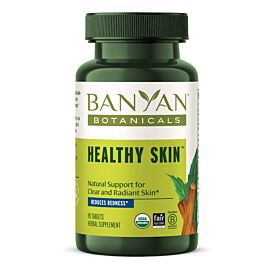What Happened When Healthy Skin Was Put to the Test?
Healthy Skin was put under the scientific microscope and the results are fascinating! Thanks to Dr. Raja Sivamani, an esteemed dermatologist with a deep passion for Ayurveda, our Healthy Skin tablets were tested to see whether they are effective in reducing pitta that manifests as facial redness and how the tablets support the healthy functioning of the skin barrier, which has a big impact on overall skin health.
Dr. Raja Sivamani has done commendable work in the field of dermatological research and is currently serving as an Associate Professor of Clinical Dermatology at the University of California, Davis. We had the good fortune and pleasure to meet Dr. Raja Sivamani at a conference a few years ago, and we are so glad that we did!
The Structure of the Study
Dr. Sivamani and his team conducted a four-week, randomized, double-blind, placebo-controlled trial with Banyan Botanicals’ Healthy Skin formulation. The trial enrolled thirty participants, who met specific requirements for participation.
Those taking Healthy Skin tablets were compared to those taking a placebo tablet and another group taking Turmeric tablets. Participants were instructed to take four tablets twice daily, or eight tablets total. Twenty-eight participants completed the study without any adverse events.
The results were very eye opening, and, while we have always had confidence in our products, we were quite excited to see exactly how effective they are!
Results of the Study
The group tested trans epidermal water loss (TEWL), or water loss through the top layer of skin, and found that there was a significant decrease in water loss through the skin in the Healthy Skin tablet group. There was no statistically significant change in TEWL for those taking turmeric or the placebo groups.
The team also used a standard grading system for evaluating facial redness. This grading system looked at the redness distribution and intensity on the face, and it essentially serves as a measure of pitta imbalance, or vikriti, in the skin. Overall, facial redness was shown to decrease by a whopping 40%!
Interpreting the Results
First of all, we want to point out that this is a small study, but nevertheless very insightful and thoughtfully done. We learned that Healthy Skin has strong effects on supporting kapha and hydration of the skin, which, in turn, promotes a healthy skin barrier and overall healthy skin.
From an Ayurvedic perspective, we know that this is preferred, given that excess ether and air elements (vata) can dry out the skin and can lead to an uneven texture. We also learned that Healthy Skin is effective at removing excess pitta from the body, including the skin, leading to an even and clear complexion. We also saw that it has promise for supporting a healthy amount of oil excretion.
We loved that Dr. Sivamani and his team tested this against a single-herb control, our Turmeric tablets, especially since taking herbs alone has become quite a trend and turmeric has gained a lot of attention, including for its role in skin health.
Turmeric is an important ingredient in Healthy Skin, but not the only ingredient. Anyone who has studied Ayurveda knows that an Ayurvedic practitioner will rarely give an herb alone. A formulation is given that includes herbs targeting the dosha imbalance, the tissue imbalance, the agni imbalance, and then harmonizing herbs (see our guide on How to Take Herbal Tablets for more information).
According to Ayurveda, skin health begins with the rakta dhatu (the blood tissue), which is why our formulation of Healthy Skin includes blood cleansers and pitta pacifiers, including manjistha, neem, turmeric, bhumyamalaki, amla (or amalaki), and guduchi.
But the dominant herb in the blend is anantamul, an herb that superbly supports and nourishes the waters of the body, while still easing pitta. This keeps the formulation from being overly drying, which can ironically increase oiliness. This may be why turmeric alone actually increased oil excretion in the study. Amla and guduchi also help to maintain a balanced digestive fire.
The result is a formulation that is well-balanced in action and uses herbs that work together towards a single final outcome—truly healthy skin.






